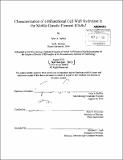| dc.contributor.advisor | Alan D. Grossman. | en_US |
| dc.contributor.author | DeWitt, Tyler A. (Tyler Anderson) | en_US |
| dc.contributor.other | Massachusetts Institute of Technology. Department of Biology. | en_US |
| dc.date.accessioned | 2014-02-10T16:57:17Z | |
| dc.date.available | 2014-02-10T16:57:17Z | |
| dc.date.issued | 2013 | en_US |
| dc.identifier.uri | http://hdl.handle.net/1721.1/84875 | |
| dc.description | Thesis (Ph. D.)--Massachusetts Institute of Technology, Department of Biology, 2013. | en_US |
| dc.description | Cataloged from PDF version of thesis. | en_US |
| dc.description | Includes bibliographical references. | en_US |
| dc.description.abstract | Integrative and conjugative elements (ICEs) are mobile genetic elements that are normally found stably integrated into bacterial chromosomes, but under certain situations can excise and transfer to a recipient cell through conjugation. ICEs contain a set of genes that encode the molecular machinery needed for conjugative transfer. Most, if not all ICEs encode an enzyme with peptidoglycan hydrolase function that is involved in transfer. While these hydrolases are widespread, they are some of the least-studied components of conjugative transfer systems, and very little is known about their function. The integrative and conjugative element ICEBsJ encodes a two-domain cell wall hydrolase, CwlT, that has both muramidase and peptidase activities. I examined the role of CwlT in ICEBs 1 transfer. CwlT is required for transfer of ICEBs1. I found that deletion of cwlT completely abrogates ICEBs] conjugation. To my knowledge, all other characterized hydrolases from conjugative systems are at least partially dispensable. The muramidase domain of CwlT is absolutely required for transfer, while the peptidase domain is partially dispensable. I determined the effect of both of CwlT's hydrolytic activities on ICEBsJ transfer, using point mutations of the catalytic domains. In order to function in conjugation, CwlT must be exported from the cytoplasm and must be able to dissociate from the cell membrane. I investigated the effect of cellular localization on CwlT activity in conjugation by using a variety of signal sequence mutants to alter CwlT's subcellular localization. Contrary to previous predictions that CwlT is a lipoprotein, I found that a deletion of its putative lipid anchor site has no effect on its role in conjugation. CwlT acts on the cell wall of the donor and not on that of the recipient. It is unclear whether hydrolases in conjugative transfer systems work on the donor cell, the recipient cell, or both. ICEBs] was able to transfer with high efficiency into species with cell wall that is indigestible to CwlT, indicating that the protein does not function on the recipient. In conjugative systems, the enzymatic specificity of the hydrolase may play an important role in determining what species mobile elements can transfer out of. | en_US |
| dc.description.statementofresponsibility | by Tyler A. DeWitt. | en_US |
| dc.format.extent | 101 pages | en_US |
| dc.language.iso | eng | en_US |
| dc.publisher | Massachusetts Institute of Technology | en_US |
| dc.rights | M.I.T. theses are protected by
copyright. They may be viewed from this source for any purpose, but
reproduction or distribution in any format is prohibited without written
permission. See provided URL for inquiries about permission. | en_US |
| dc.rights.uri | http://dspace.mit.edu/handle/1721.1/7582 | en_US |
| dc.subject | Biology. | en_US |
| dc.title | Characterization of a bifunctional cell wall hydrolase in the mobile genetic element ICEBsJ | en_US |
| dc.title.alternative | Bifunctional cell wall hydrolase functions in the donor during conjugation of an integrative and conjugative element | en_US |
| dc.type | Thesis | en_US |
| dc.description.degree | Ph.D. | en_US |
| dc.contributor.department | Massachusetts Institute of Technology. Department of Biology | |
| dc.identifier.oclc | 868666331 | en_US |
